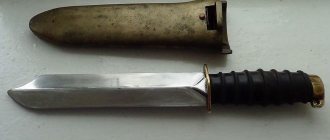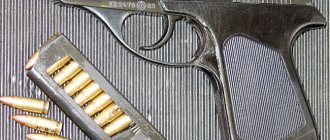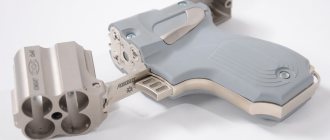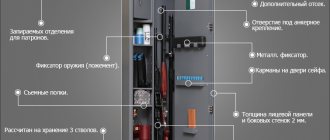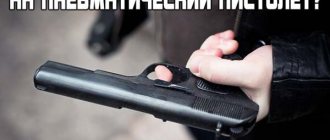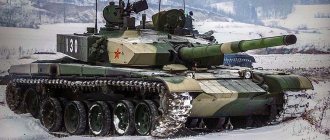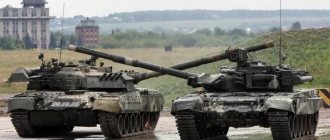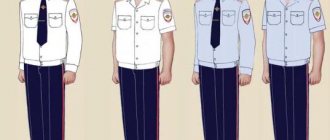Good day, Friends! I thought I wouldn’t write another article until the end of the month…. But it turned out differently. Of course, you probably noticed that there are very few articles in October - this is due to the fact that I am very busy at my main job. This month we also had a check, so there was very little time left for the site. But enough making excuses - it's time to get down to business. By the way, there will be some more news at the end of the article. Now let's move on to the topic of our discussion today - edged weapons called - checker.
Checker
- This is a combat, chopping and piercing, long-bladed edged weapon. At one time, when military theorists decided on the question of what would be better to equip cavalry to achieve the greatest efficiency, a decision was made in favor of the checker. The decision, unfortunately, was a little late. First in the Caucasus, and then in Russia, the saber replaced the saber with the spread of firearms and the cessation of the use of metal armor. In the 19th century it became one of the main types of cutting and piercing weapons of the Imperial Russian army.
Features of the structure, wearing and use of checkers
The weapon consists of a blade and a handle, which is called a hilt. The blade, the standard length of which is 1 m, has one blade, but at the combat end it becomes 2-bladed. The blade is slightly curved. The hilt of a checker usually consists of a handle without a cross, which ends with a head. At the end it usually bifurcates.
There is a category of researchers who believe that the saber and the checker are relatives. In fact, the confusion occurs because there are two types of checkers:
- with a guard (brace), similar in appearance to a saber (dragoon type),
- more common without a guard (Caucasian and Asian types).
Checkers: a - Caucasian model 1904; b - dragoon model 1881
The statement of similarity is also based on the fact that this is a bladed weapon with a long blade, intended for inflicting slashing wounds. The broadsword , a direct stabbing weapon, also belongs to this type At the same time, the fundamental difference between a checker and a saber lies precisely in the method of combat use . Everyone knows that with a saber they only chop, but with a saber they chop, stab, and even trim.
It is always necessary to remember that a checker is NOT a type of saber. External differences are also fundamental. They consist in the traditional absence of a guard and a pronounced tip, in the minimal curvature of the blade and its different balancing.
The method of using combat influenced the way the sheath of the checker was attached. Unlike the saber, the saber was carried in a wooden scabbard, butt first. It was customary to cover the scabbard with leather. They were attached to the waist or shoulder belt using one or two rings, which were secured on the curved side.
They used the saber both in battle and to repel a sudden attack, and therefore it was sheathed with the blade up. To perform a chopping blow, it is easier to remove it from this position: it is grabbed in one movement without changing the position of the hand. According to the characteristics of wearing and use, the checker is closer to the samurai katana sword .
This type of bladed weapon also has a similar blade shape.
Caucasian blade
0
Since ancient times, the Caucasus has been engulfed in constant fighting - both between local residents and external invaders. Various types of checkers as weapons were considered an integral attribute of any man. Blades were constantly developed and improved to combat enemies more effectively. For example, thanks to the strengthening of the tip of a checker, it became possible to break the rings of chain mail and destroy the enemy, despite his protection. The history of the development of the checker shows that the weapon was not invented by the peoples of the Caucasus. It came from Persia. At that time, daggers with just such a blade, designed to destroy a protected enemy, were popular there. When firearms appeared and chain mail ceased to be a reliable protection, the need for a saber, which coped well with this type of armor, disappeared. The opponents of the highlanders, knowing that after a shot they needed time to reload, after the enemy’s volley they immediately rushed into battle. There was little time to grab the weapon, but the saber and its specific mount in the sheath with the blade facing up made it possible to use it almost instantly. The Cossacks lived in the border areas and were a special social stratum. They were hardly influenced by state power and their thinking was affected by the constant danger of war. Their culture was also enriched by their enemies - they adopted the tricks and weapons of eastern warriors and steppe people. The Cossacks' arsenal was largely replenished with war trophies, and the habit of wearing mustaches, bright clothes and curved blades - all this is reminiscent of the Turkish and steppe peoples. The Cossacks borrowed the saber from the warriors of the Caucasus. Initially, it lived up to its name “sashkho” - a long knife. It was worn almost under the armpit of the left hand, and it served as an auxiliary or spare weapon. According to contemporaries, after being hit by a Cossack saber, the enemy rarely remained alive. Moreover, there is information that the weapon could cut the rider in half, right down to the saddle, and even injure the horse. The warhead of the blade was sometimes made double-edged, but only at the personal request of the owner. The butt formed a false blade, which in turn made the wounds from the weapon deeper. Therefore, the meaning of a double-edged blade was only for a warrior who used combat tactics that differed from the generally accepted ones.
Checker parameters
The length of the checker reached a meter, but the standard was 70-90 cm. The width of the blade was made up to 40 mm, and for the Caucasian checker with a pronounced curve and sharpening of the blade on the convex side, a width of up to 30 mm was typical. The blade was usually decorated with special engraving. They made it in Zlatoust or Kizlyar. The Caucasian checker was also characterized by the so-called “dales” - longitudinal depressions.
Saber with scabbard
Gift checker
Checker
The Russian saber , which entered service with the Russian army, was distinguished by the type of hilt and scabbard. In total, several types of Russian saber . Three of them were intended for dragoons, Cossacks and artillerymen . Two types were produced for general arms and Cossack officers. Another type was a combination of Cossack and Dragoon.
Origin theories
0
The previously mentioned Circassians and Adygeis. Initially used for cutting brushwood and vines. The Nogai Tatars used a kind of checker to pierce meat and fry it over coals. This is where the name shish kebab comes from - shash, the name of the blade, and bast, i.e. meat. Cavalry sabers, up to 1.5 meters long, were modified by the Grebensky Cossacks for the conditions of mountain warfare. During the Mamluk dynasty, in Egypt, the first version of the cavalry saber appeared, which in the future, as a captured weapon, came to the Caucasus and was slightly modified.
Types of short Cossack weapons
All the Cossacks were armed with swords. This is the most important accessory for a fighter of that time. The checker differed from the saber in one important element: it had neither a crosshair nor a protective bow. This allowed the Cossack to inflict damage on the enemy with a special wrist blow. But, in addition to the saber, any Cossack was armed with a dagger. There were two types of daggers, straight - kama and curved - bebut. The stories of both go back thousands of years. Over the course of several centuries they have changed slightly. The Cossacks themselves loved to take blades as trophies and then kept for themselves the most convenient ones, in their opinion. They really liked Caucasian blades, which were so varied in length and quality that it is impossible to say exactly at what time the Cossacks were armed with which blades. The Cossacks had only two statutory daggers: this is the ChKV dagger, approved in 1840. and KKV 1904.
Another very important blade was a boot knife - a stiletto. This weapon was of last resort, it was rarely used, but it often saved lives.
Modern replicas
As has already been said many times about the historical features of the Plastun blade, a product made from a broken checker is, in fact, not an original Plastun Cossack knife. But I would like to note that although the brand is of the 21st century, it is quite good in its qualities.
These are good quality, interesting and working knives that are suitable for use in a variety of conditions. They are produced in Russia in different cities: Zlatoust, Volgograd, Vorsma (Nizhny Novgorod region), etc. And each manufacturer is unique in their own way in the production of this knife.
A modern replica of the Cossack Plastun knife.
Features of women's attire
Over time, the cut of the suit and its elements changed. They are most clearly visible in men's clothing.
The women's Cossack costume has changed little over time, but it has more pronounced ethnic features in the decoration and shape of clothing, shoes, and hats. This was explained by the fact that women for a long time retained in their clothing the traditional features of the attire of the places from which they came to the Don.
In addition, among the newly minted Cossacks there were many Tatars, Turkish women, and Nogai women who were taken to the Cossacks as captives. They introduced elements of their peoples into women's costumes, which made the clothes bright and unique. The headdresses of women's Cossack costumes were also varied, sometimes of the most bizarre shapes.
And only in the 19th century did the ancient Cossack costumes of women become a thing of the past. Under the influence of urban fashion, they are being replaced by the so-called couple: an outfit consisting of a skirt and a jacket.
The places of settlement of the Cossacks were quite wide, but their concentration was especially high on the Don and Kuban; Later, their settlements appeared on the banks of the stormy Terek. From the point of view of the feasibility of their resettlement, the choice of these places was completely justified. For a long time, the south of Russia was inaccessible to imperial power.
The Cossack freemen, which united fugitive peasants, rebels, and dispossessed people, posed a serious danger to the authorities. They not only wanted to obey her, did not follow the decrees and orders, but they could also physically destroy the official who came to them if they suspected in him the danger of infringement of their rights. Therefore, the bureaucratic tribe did not try to appear here again.
History of Cossack weapons
If the Cossacks did not use such a blade, then what kind of knife did the Plastun and ordinary Cossack detachments use? Many researchers suggest simply looking at photographs from those years. Of which, fortunately, there are quite a few left. They can be found in various museums, and there are many of them on the World Wide Web.
In photographs taken just a century ago, it is quite easy to see the edged weapons that the Cossacks are armed with. The Cossack always had a knife at hand and in almost all photos you can see the most popular dagger among the Cossacks, it was called kama. And another curved dagger, but it is much less common - the bebut. But the most interesting thing is that the widely known Plastun knife today cannot even be found in photographs.
Versions of occurrence
There are two versions of the origin of this legendary edged weapon. According to the first version, during the defense of the southern borders of the Russian Empire. The Don and Kuban Cossacks had, in addition to cavalry units, very strong foot units. Among them were special sabotage detachments that made forays into enemy territory at night. Each fighter had a Cossack knife with him, and thanks to such a silent weapon they caused enormous damage to the enemy.
They say that one could get into such a detachment only thanks to the recommendation of the commander himself. Accordingly, it was believed that to perform such tasks, fighters were equipped with special blades, which moved from the category of simple daggers to the Cossack Plastun knife. This version is not supported by anything, so whether you believe it or not is up to you.
According to the second version, the Plastun knife was awarded to especially distinguished fighters. For repeated sabotage and reconnaissance actions, for the manifestation of repeated courageous actions. It was not a blade for everyday wear. And it was awarded only to those who excelled in combat operations. Thus, the owner of such a knife became an indicator of the status of the Cossack.
But in fact, the Cossacks lived by the principles that everyone is equal. So to single someone out from others was a sign of bad manners. In accordance with these principles of life of the Cossacks, the version can be refuted.
Old Cossack Plastun knife.
Who are plastuns?
There is a very interesting legend about the Plastun Cossacks, supposedly they were hungry and beggars. They begged rich Cossacks for broken checkers, then they were converted into blades. But there are many inconsistencies here, from a historical point of view. In Kuban there is a whole village called Plastunovskaya. So the whole village was starving?
On the contrary, the Plastun Cossacks were considered, as they are now, an elite unit of the Cossack troops. There were no young and hot guys in such units. Since they were engaged in sabotage and intelligence activities, completely different human qualities were needed:
- patience;
- composure;
- military skill;
- lack of fear of death;
These qualities were inherent in real plastuns. And they made them real, invincible soldiers. In reconnaissance, we often had to crawl on our bellies, hence the name of these brave guys. Well, and of course, they had Cossack plastun knives with them.
